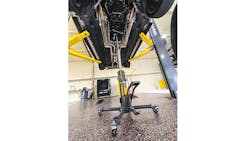Tech Tip: Make sure your transmission jack isn’t out of whack
Installing a new transmission or removing the old one can be a challenge without a properly working transmission jack. These powerful, multitask lifting systems are essential in most vehicle repair shops.
However, transmission jacks can only do their jobs if they are properly maintained, regularly inspected for damage, and used correctly. Here are eight tips for maintaining your transmission jacks.
- Regularly lubricate all moving parts. Pay special attention to the lift screw and related linkages. A medium-weight lubricating grease should be used on all external moving parts, such as the bearing surface, pivot points, and tilt screws.
- Regularly check the oil level and top off as needed.
- Use only hydraulic jack oil. Do not use hydraulic brake fluid.
- If the jack fails to operate, check the oil level and/or bleed the unit before seeking service.
- Do not use a transmission jack as a wash rack when washing or steam-cleaning transmissions.
- Before each use, follow the pre-check list provided by the manufacturer to ensure components are in good working order. If any issues are found, remove the jack from service until repaired.
- Do not use the jack if you believe it has been subjected to an abnormal load or shock. If in doubt, contact a local service agent.
- Periodically check the pump piston rod for signs of corrosion. Clean exposed areas with an oiled cloth.
Information provided by: BendPak, Inc.
